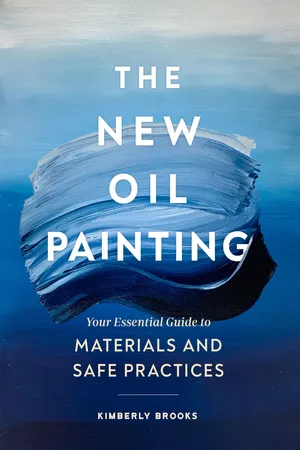
The New Oil Painting
Your Essential Guide to Materials and Safe Practices
- 232 pages
- English
- ePUB (mobile friendly)
- Available on iOS & Android
About this book
Here is everything you need to know about getting into oil painting—and maintaining a safe, solvent-free oil painting practice—in a slim, sophisticated guide. Oil painting is an exciting and adventurous medium, but aspiring artists can feel daunted by complex setups and the thought of using harsh chemicals. All of that changes now. The New Oil Painting walks you step-by-step through oil painting fundamentals—which materials you actually need, how to mix paint, how to set up your painting space—and, most revolutionary of all, how to eliminate harmful solvents from your work and replace them with safe, effective substitutes. This instructional handbook is organized into chapters with helpful diagrams throughout illustrating various techniques and tools. Whether you're a true beginner or have been painting with oils for years, you will find that this book has everything you need to build a new, thriving, toxin-free practice.• UNIQUE APPROACH: Not only does this book help aspiring artists build a repertoire of skills and materials, it also offers all artists, regardless of their experience levels, methods for eliminating solvents and other toxic substances from their oil painting practices. What was once a dangerous pastime is now a guilt-free, health-conscious, and rewarding activity. And using safe, nontoxic materials is better for the environment!
• LONG-TERM USE: Good art instruction can deliver over a long period of time, and this handy guide is no exception. Along with being able to use this as an entryway into oil painting, you can also use it for reference or reread sections when you need a brushup.
• EXPERT AUTHOR WITH IMPRESSIVE CREDENTIALS: Painter Kimberly Brooks was the founding arts editor at Huffington Post. As a painter, she exhibits her work frequently throughout the United States and was a featured artist with the National Endowment for the Arts. She has led oil painting workshops, and now she shares her vast knowledge of the subject in this accessible and comprehensive handbook.Perfect for: • Artists and art aspirants interested in exploring a new medium
• Experienced oil painters looking to eliminate solvents from their practices
• Painting students and teachers
Frequently asked questions
- Essential is ideal for learners and professionals who enjoy exploring a wide range of subjects. Access the Essential Library with 800,000+ trusted titles and best-sellers across business, personal growth, and the humanities. Includes unlimited reading time and Standard Read Aloud voice.
- Complete: Perfect for advanced learners and researchers needing full, unrestricted access. Unlock 1.4M+ books across hundreds of subjects, including academic and specialized titles. The Complete Plan also includes advanced features like Premium Read Aloud and Research Assistant.
Please note we cannot support devices running on iOS 13 and Android 7 or earlier. Learn more about using the app.
Information
PART 1
UNDERSTANDING YOUR MATERIALS
YOUR SPACE

EASELS
$ | Stanrite #500 Aluminum Easel |
Easels by Blick Studio | |
Creative Mark Table Easel | |
SoHo Urban Artist Lightweight Mahogany French Easel (INCLUDES DRAWER) | |
Blick French Easel by Jullian (INCLUDES DRAWER) | |
$$ | Testrite “Superior” Studio Easel |
The Dulce Easel | |
Creative Mark Mirage All Media Adjustable Studio Easel (WITH WHEELS) | |
Da Vinci Multi-angle Convertible Easel | |
$$$ | Santa Fe Easel |
Halley Easel | |
University Easel |
PAINT


PIGMENT

BINDER

ADDITIVES
Table of contents
- Cover
- Title
- Dedication
- Copyright
- Contents
- Introduction
- Understanding your Materials
- Best Practices
- Glossary
- Resources
- Bibliography
- Acknowledgments
- About the artist
- Index
- Chronicle Ebooks
